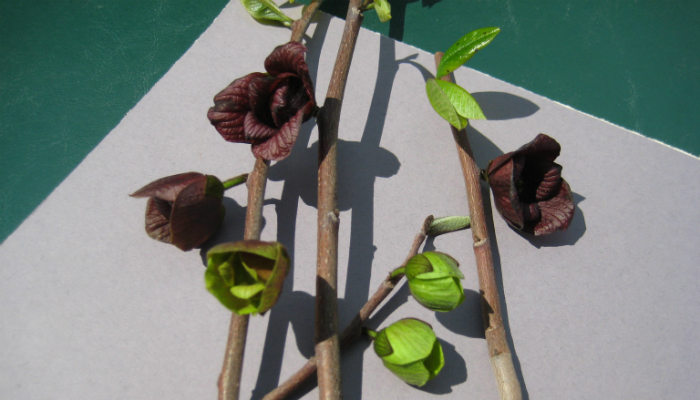Update on Pawpaw Plantation: They’re Blooming!

Pawpaw flowers in stages of development. In my slightly sheltered microclimate in western Johnson County they do not appear to have been damaged by the scattered light frosts of May 14/15.
You perhaps already know from my “2015 Annual Report for Rare Plant Project” blog that I have been developing a four-acre plantation for rare native butterflies by growing a collection of the rare native plants they are obligate to. Today’s post is to mention that of the 43 pawpaws I started from seed in 2010*, this spring 18 are flowering, as are another dozen younger plants mostly from the 2011 planting. This is my first flowering in this plantation – perhaps responding to our mild winter just completed – and it’s an important step for this butterfly project. I’m hopeful that I will have some fruit in late summer, but because their caterpillars only eat the leaves, this will not influence the zebra swallowtail butterflies who come to visit.
I started seeing signs of flowering right after my apple trees first bloomed, and the pawpaw flower buds were still developing when lilacs bloomed. The pawpaw flower buds first look like a green pea on a stalk. The pea then enlarges and opens partially into a pretty, downward-facing green bell. At this stage, the female portion becomes receptive to pollination by insects traveling from older flowers. The bell then enlarges and flairs while turning from a green to a reddish or purplish brown and then to a chocolate color. Anthers then mature and offer pollen to visitors. The pollinators are small beetles, red admiral butterflies, and tiny flies, and at this stage the flower has a faint musky/fermenting odor, which probably helps attract these pollinators. The flared flowers, when backlit by bright sunshine, are slightly translucent, which several book authors have described as voluptuous, fleshy, meaty, or lurid. While it is true that pollination is all about sex, these descriptions may more accurately portray their authors’ states of mind than the flowers.
No nectar is offered, so honeybees and bumblebees are not attracted to the flowers. The geologic record of pawpaw/pollinator evolution is skimpy, mostly leaf prints in shale and insects in amber, but it looks like the pawpaw family evolved long before bees, by perhaps 25 million years, and evolution has subsequently said that if it ain’t broke, don’t fix it. Given how we are treating bees today, it seems like sound policy for our era.
The individual flowers usually produce one fruit, but sometimes yield a cluster of 3 or 4. A guy I correspond with back in my home area near Niagara Falls grows pawpaws for a local farmers market and other small-scale sales. He mentioned that he helps assure pollination, especially in unfavorable weather, by scattering roadkill to attract insects. He is also a guy who might sucker you into a tall tale and I don’t know whether to believe him or not, so for this year, I will forgo the experimental opportunity and just watch how well fruits develop near and far from each other, because cross-pollination is important to the species.
Besides being a rare native fruiting plant, which supports a rare native butterfly, I suspect that pawpaw could be uniquely well-adapted to permaculture. Later this year, when I have wrapped up a series of little experiments – based in part upon the fruits from these blossoms – I will post a blog regarding pawpaw opportunities in local permaculture. Pawpaw fruits from other local sources are becoming available but are generally misunderstood. In mid-summer, I will also post a blog about harvesting, eating, and preserving the fruit. Stay tuned!
*Special thanks to Tom Wahl for giving me a sack of rotten pawpaw fruit in autumn 2009, plus good advice on how to get the seeds started.
Tags: butterfly habitat, Lon Drake, microclimates, pawpaw

